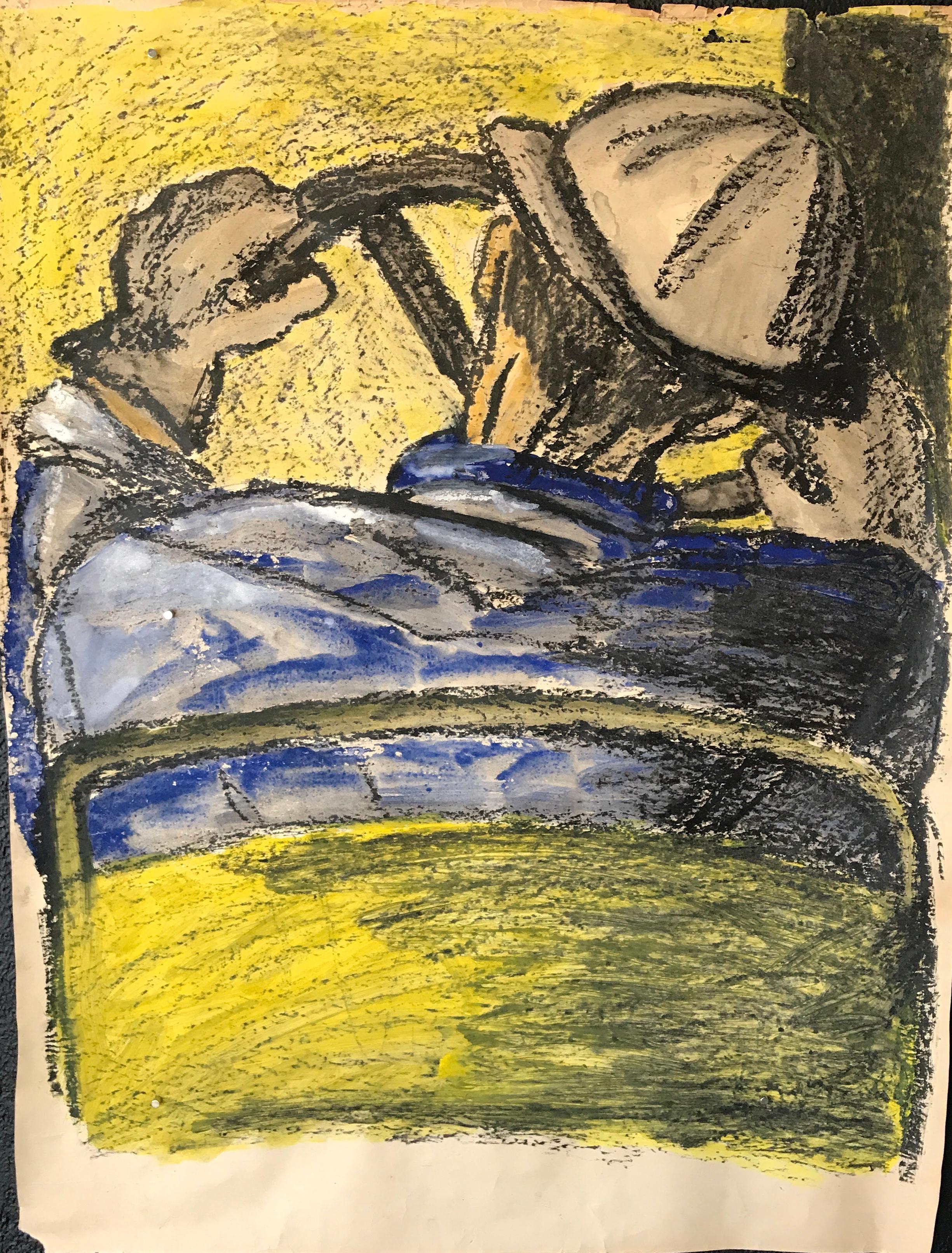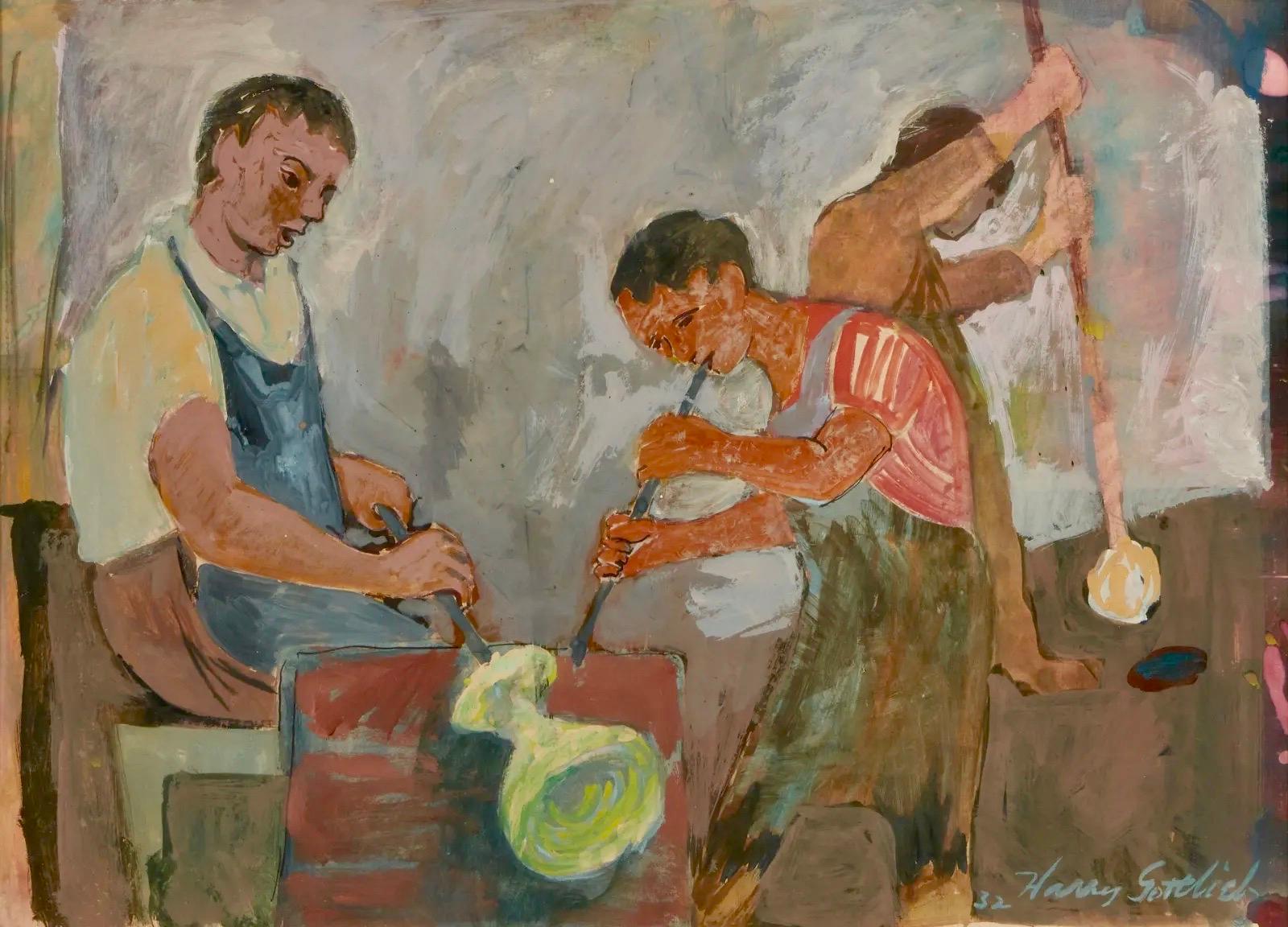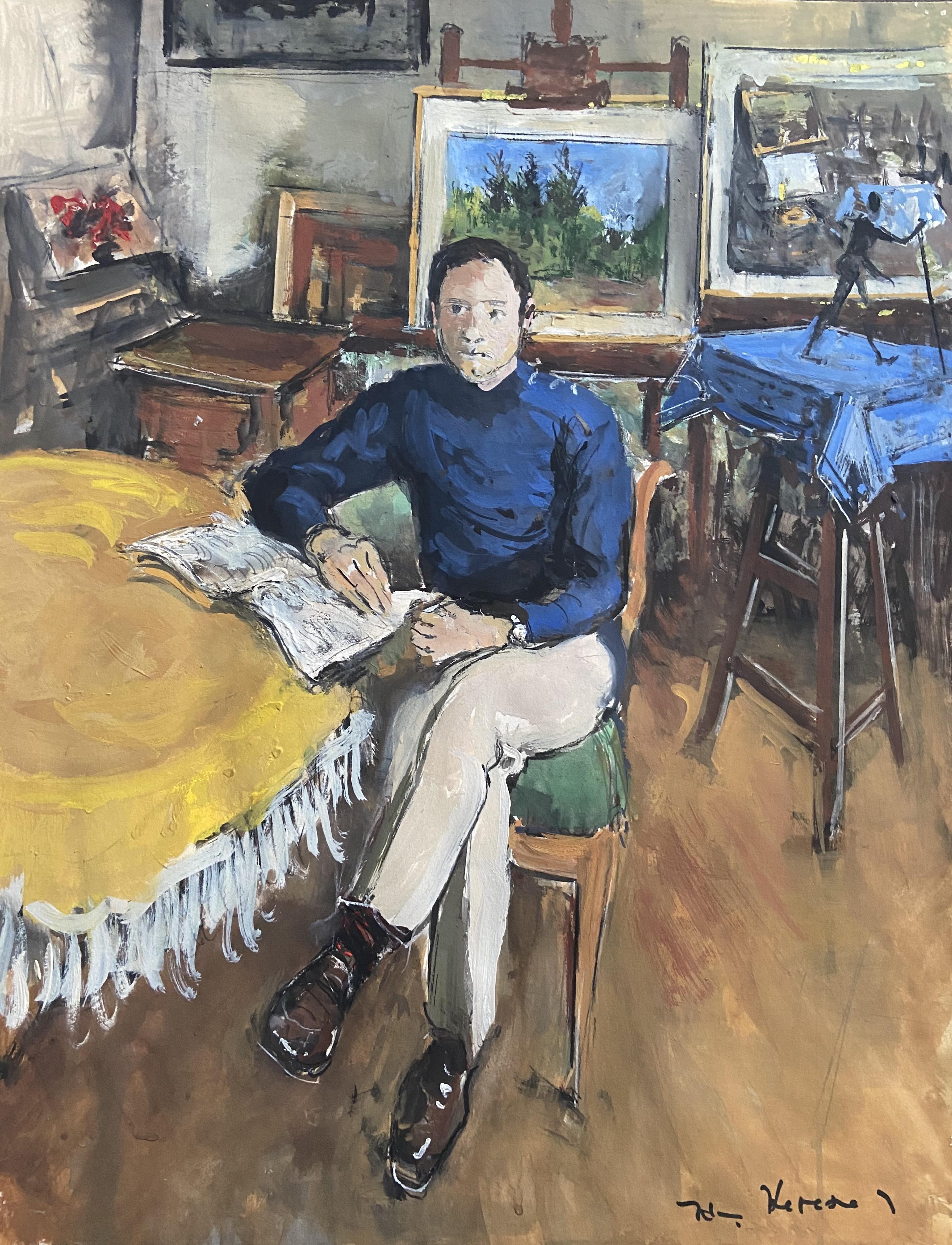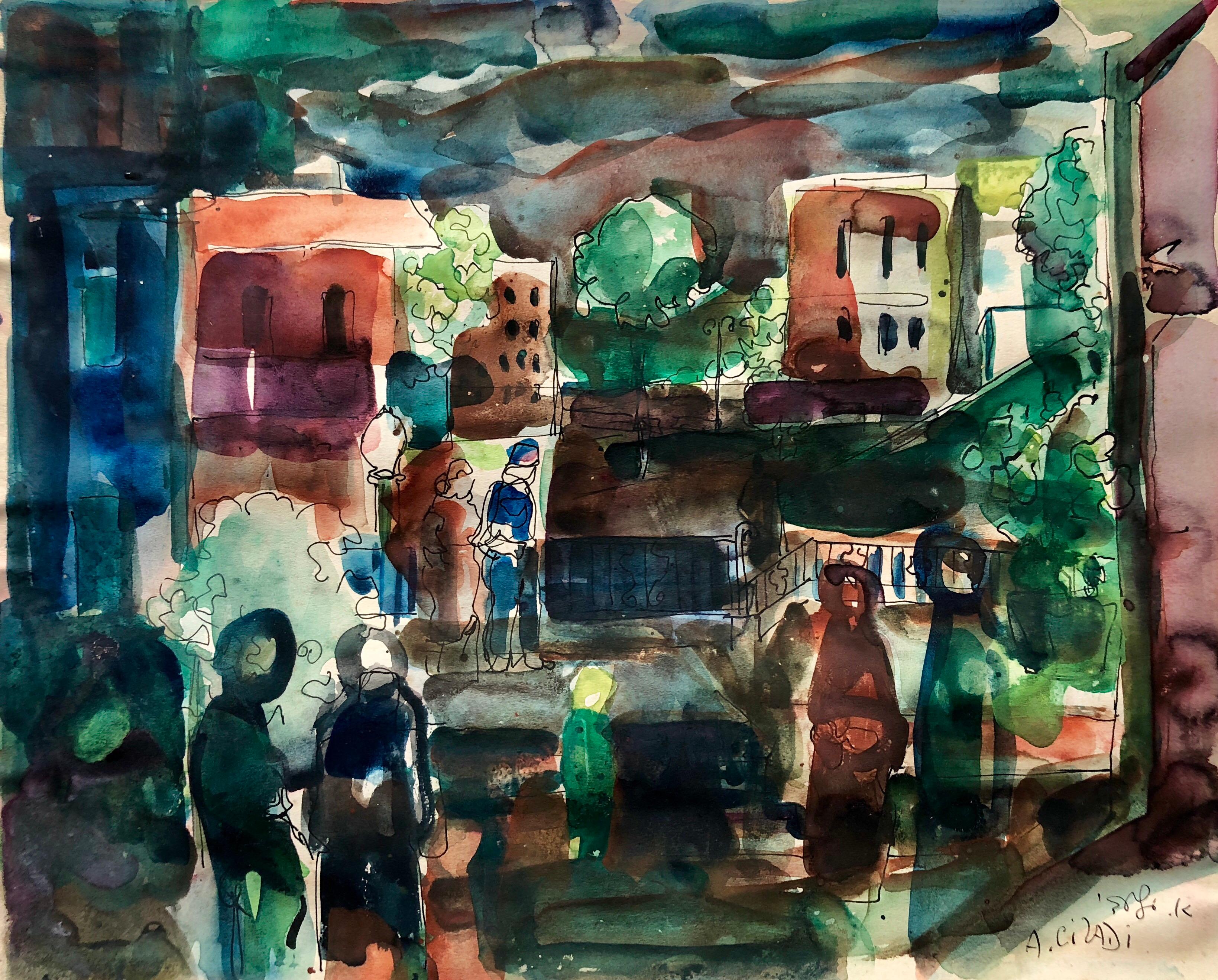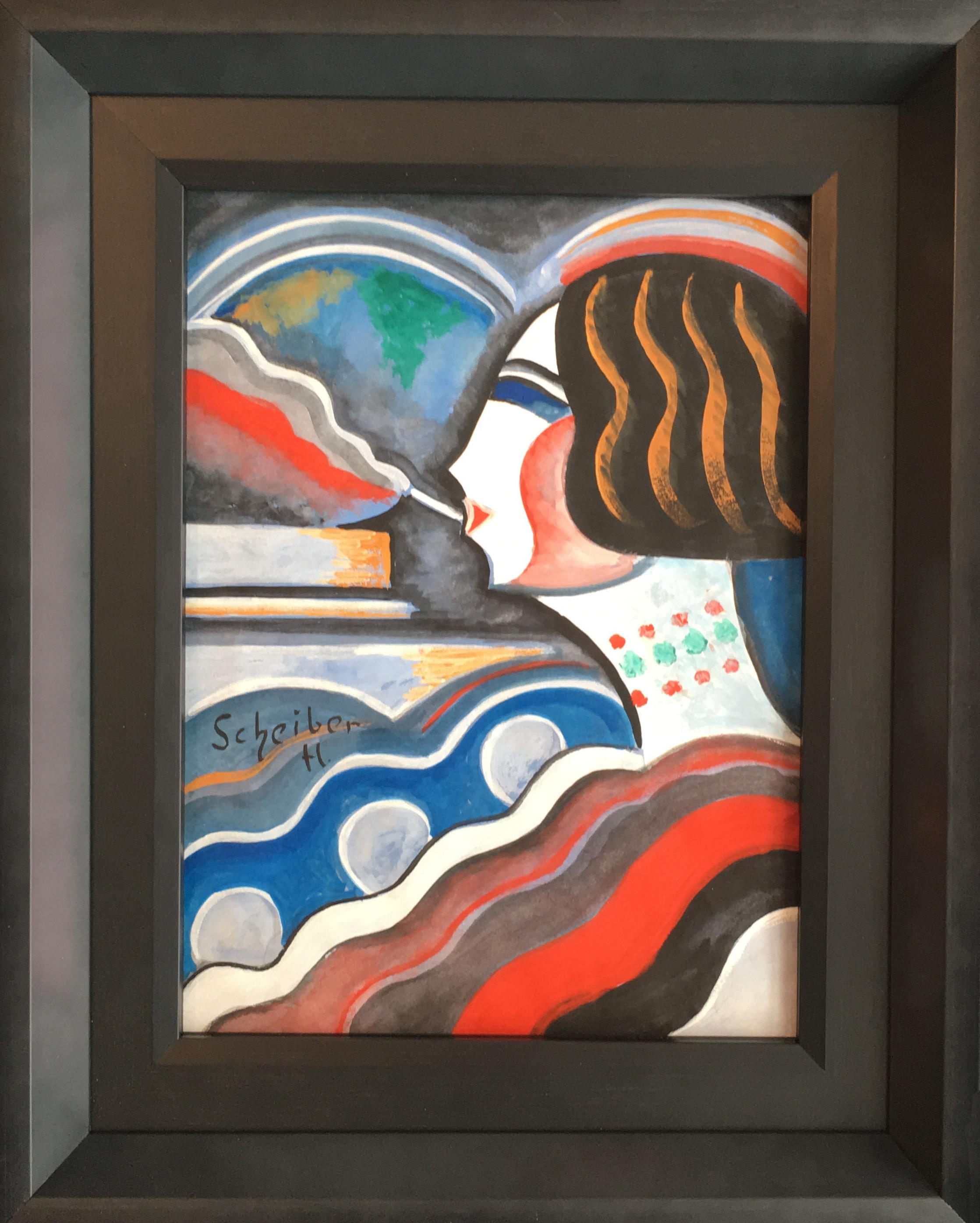Items Similar to The Necklace and the Pot
Want more images or videos?
Request additional images or videos from the seller
1 of 11
Gisella LoefflerThe Necklace and the Potc. 1919
c. 1919
About the Item
Gisella Loeffler
"The Necklace and the Pot" c. 1919
Gouache on Paper
Initialed Lower Left
Framed Size: approx 15 x 15 inches
In a village filled with colorful characters, few Taos artists were as colorful as Gisella Loeffler [1900-1977]. From her handmade Austrian clothing and hand-painted furniture to whimsical paintings and letters written in multicolored crayon, joyful color defined the artist, who early on chose to use simply Gisella as her professional name and was known as such to everyone in Taos.
In spite of her fame there—the Taos News once labeled her a Taos legend—Gisella is rarely included in scholarly discussions of the Taos Art Colony. This oversight is likely due to the naive quality of her work, in which children or childlike adults inhabit a simple, brightly colored world filled with happiness. The macabre, the sad, the tortured, the offensive—all have no place in Gisella’s paintings. Her naive style of work looks very different from that of the better-known early Taos artists. Yet both Gisella’s artwork and her interesting life command attention.
Born in Austria, Gisella came to the United States with her family in 1908, settling in St. Louis, MO. After studying art at Washington University in St. Louis, she became a prominent member of the local art community, joining the St. Louis Art Guild as well as the Boston Society of Arts and Crafts. In addition to creating posters for the St. Louis Post Dispatch, Gisella won prizes from the Artists Guild of the Author’s League of America in 1919 and 1920 and from the Kansas City Art Institute in 1923. She also began working in textiles, including batik, to which she would return later in her career.
In the early 1920s Gisella married writer and music critic Edgar Lacher. A difficult character, Lacher may have chafed under Gisella’s success, for the couple divorced in the 1930s.
Having seen a local exhibition of paintings by Taos artists Oscar Berninghaus (who was from St. Louis) and Ernest Blumenschein, Gisella felt drawn to Taos, which reminded her of the villages of her native Austria. In 1933 the single mother with two daughters, Undine and Aithra, moved to Taos, where she lived off and on for the rest of her life. She traveled frequently, spending extended periods in Mexico, South America, and California, but always returned to New Mexico.
Gisella initially applied an Austro-Hungarian folk-art style to the Indian and Hispanic subjects that she found in New Mexico. In her early work she covered her surfaces with decorative floral and faunal motifs, and her images were flat with no attempt at rendering traditional one-point perspective. Eventually, though, Gisella developed her own style, often using children or childlike figures as subjects. Still, the influence of her native country’s folk art remained evident in her New Mexican, Mexican, and South American images.
In 1938 Gisella moved briefly to Los Griegos, north of Albuquerque, to be closer to medical facilities for her eldest daughter, who was suffering from rheumatic fever. Two years later, she moved to California to participate in the war effort, painting camouflage and decals on airplanes for Lockheed.
In California, Gisella broadened her range of artistic pursuits. She taught art privately, created illustrations for Scripts Magazine, and did interior design for private homes. She also designed greeting cards, a practice she continued after her return to New Mexico, where she created a series of Christmas cards.
Gisella began illustrating children’s books in 1941 when she collaborated on Franzi and Gizi with author Margery Bianco. Eventually she wrote and illustrated her own book, El Ekeko, in 1964. She also designed ceramics—her Happy Time Dinnerware, marketed by Poppy Trail and manufactured by Metlox of Manhattan Beach, CA, is highly collectible today.
In 1948 Taos art patron Mabel Dodge Luhan persuaded Gisella and her new husband Frank Chase to return to Taos. The couple lived in the former adobe home of writer D.H. Lawrence and were frequent visitors to the Luhan compound, where Mabel took Gisella into her circle of artist friends. In this environment, the color and joy that were integral to Gisella’s life permeated everything she did, from painting virtually all the surfaces—including the windows—in the Luhan home with bright colors and natural motifs to performing impromptu dances or singing Austrian folk songs with Taos artist Joseph Fleck, a fellow Austrian, at the Luhans’ frequent parties.
Gisella was enchanted by colorful scenes outside of New Mexico as well. In the early 1950s she began visiting South America, where her daughter Undine lived with her husband Ernesto Gutierrez, a U.S. State Department official. First in Bolivia, then in Peru, Gisella was taken with the bright costumes and traditions of the people she encountered. She later patterned much of her handmade clothing after South American costumes seen on these trips. Also intrigued by Mexico, Gisella traveled there as frequently as possible.
Throughout her life, Gisella corresponded regularly with her many friends. Typically her letters were illustrated in crayon or colored pencil with some object or scene from a recent experience. The text of her letters was also written with multiple colors of crayon or colored pencil. A letter from Gisella was always a visual feast.
As a painter, she worked on canvas or paper in oil, casein, and watercolor. She also painted furniture. Besides making her own clothing, Gisella worked in other fabric arts such as batik and embroidery. In fact, she received the top award in fabric arts in 1959 and again in 1967 from the Mus-eum of International Folk Art in Santa Fe. But perhaps Gisella’s greatest legacy is the murals she painted for children’s areas in hospitals across the United States.
Mabel Dodge Luhan may have summed up Gisella’s contributions best when she wrote in her 1947 book Taos and Its Artists: “Gisella Loeffler! How people are attracted to your unny little painted children and the reassuring life you surround them with! This is a real folklore you give us. Everyone is allured and amused by the life of these robust infants with roses and birds and hearts all about them. It makes people forget that sometimes their life is not so gay. These children you paint are very simple and have the sweet peasant charm. Where do you find it? In a faraway Hungarian gypsy grandmother? Or is it really right here beside us all the time, and we too dull and preoccupied with the inconvenience of a mechanical world to be aware of it?”
Gisella’s death in 1977 left a large hole in the fabric of the Taos Art Colony and the entire Taos community. Yet her work, so colorful and full of joy, remains an uplifting presence in Taos.
Michael R. Grauer is curator of art at the Panhandle-Plains Historical Museum in Canyon, TX, which held solo exhibitions for Gisella in the 1950s and ’60s and was the recipient of Gisella’s estate. The museum owns some 30 pieces of her paintings, prints, decorative artworks, and furniture as well as more than 260 illustrated letters.
- Creator:Gisella Loeffler (1902 - 1977, American, Austrian)
- Creation Year:c. 1919
- Dimensions:Height: 15 in (38.1 cm)Width: 15 in (38.1 cm)Depth: 0.5 in (1.27 cm)
- Medium:
- Movement & Style:
- Period:
- Condition:
- Gallery Location:Missouri, MO
- Reference Number:1stDibs: LU74733212483
About the Seller
5.0
Vetted Seller
These experienced sellers undergo a comprehensive evaluation by our team of in-house experts.
Established in 1970
1stDibs seller since 2017
Typical response time: 21 hours
- ShippingRetrieving quote...Ships From: Missouri, MO
- Return PolicyA return for this item may be initiated within 2 days of delivery.
More From This SellerView All
- Three GirlsBy Gisella LoefflerLocated in Missouri, MOGisella Loeffler "Three Girlsl" c. 1919 Gouache on Paper Initialed Lower Left Framed Size: approx 19 x 13 inches In a village filled with colorful characters, few Taos artists were as colorful as Gisella Loeffler [1900-1977]. From her handmade Austrian clothing and hand-painted furniture to whimsical paintings and letters written in multicolored crayon, joyful color defined the artist, who early on chose to use simply Gisella as her professional name and was known as such to everyone in Taos. In spite of her fame there—the Taos News once labeled her a Taos legend—Gisella is rarely included in scholarly discussions of the Taos Art Colony. This oversight is likely due to the naive quality of her work, in which children or childlike adults inhabit a simple, brightly colored world filled with happiness. The macabre, the sad, the tortured, the offensive—all have no place in Gisella’s paintings. Her naive style of work looks very different from that of the better-known early Taos artists. Yet both Gisella’s artwork and her interesting life command attention. Born in Austria, Gisella came to the United States with her family in 1908, settling in St. Louis, MO. After studying art at Washington University in St. Louis, she became a prominent member of the local art community, joining the St. Louis Art Guild as well as the Boston Society of Arts and Crafts. In addition to creating posters for the St. Louis Post Dispatch, Gisella won prizes from the Artists Guild of the Author’s League of America in 1919 and 1920 and from the Kansas City Art Institute in 1923. She also began working in textiles, including batik, to which she would return later in her career. In the early 1920s Gisella married writer and music critic Edgar Lacher. A difficult character, Lacher may have chafed under Gisella’s success, for the couple divorced in the 1930s. Having seen a local exhibition of paintings by Taos artists Oscar Berninghaus (who was from St. Louis) and Ernest Blumenschein, Gisella felt drawn to Taos, which reminded her of the villages of her native Austria. In 1933 the single mother with two daughters, Undine and Aithra, moved to Taos, where she lived off and on for the rest of her life. She traveled frequently, spending extended periods in Mexico, South America, and California, but always returned to New Mexico. Gisella initially applied an Austro-Hungarian folk-art style to the Indian and Hispanic subjects that she found in New Mexico. In her early work she covered her surfaces with decorative floral and faunal motifs, and her images were flat with no attempt at rendering traditional one-point perspective. Eventually, though, Gisella developed her own style, often using children or childlike figures as subjects. Still, the influence of her native country’s folk art remained evident in her New Mexican, Mexican, and South American images. In 1938 Gisella moved briefly to Los Griegos, north of Albuquerque, to be closer to medical facilities for her eldest daughter, who was suffering from rheumatic fever. Two years later, she moved to California to participate in the war effort, painting camouflage and decals on airplanes for Lockheed. In California, Gisella broadened her range of artistic pursuits. She taught art privately, created illustrations for Scripts Magazine, and did interior design for private homes. She also designed greeting cards, a practice she continued after her return to New Mexico, where she created a series of Christmas cards. Gisella began illustrating children’s books in 1941 when she collaborated on Franzi and Gizi with author Margery Bianco. Eventually she wrote and illustrated her own book, El Ekeko, in 1964. She also designed ceramics—her Happy Time Dinnerware, marketed by Poppy Trail...Category
1910s Modern Figurative Drawings and Watercolors
MaterialsGouache
- Going for a StrollBy Gisella LoefflerLocated in Missouri, MOGisella Loeffler "Going for a Stroll" c. 1919 Gouache on Paper Initialed Framed Size: approx 17 x 13 inches In a village filled with colorful characters, few Taos artists were as colorful as Gisella Loeffler [1900-1977]. From her handmade Austrian clothing and hand-painted furniture to whimsical paintings and letters written in multicolored crayon, joyful color defined the artist, who early on chose to use simply Gisella as her professional name and was known as such to everyone in Taos. In spite of her fame there—the Taos News once labeled her a Taos legend—Gisella is rarely included in scholarly discussions of the Taos Art Colony. This oversight is likely due to the naive quality of her work, in which children or childlike adults inhabit a simple, brightly colored world filled with happiness. The macabre, the sad, the tortured, the offensive—all have no place in Gisella’s paintings. Her naive style of work looks very different from that of the better-known early Taos artists. Yet both Gisella’s artwork and her interesting life command attention. Born in Austria, Gisella came to the United States with her family in 1908, settling in St. Louis, MO. After studying art at Washington University in St. Louis, she became a prominent member of the local art community, joining the St. Louis Art Guild as well as the Boston Society of Arts and Crafts. In addition to creating posters for the St. Louis Post Dispatch, Gisella won prizes from the Artists Guild of the Author’s League of America in 1919 and 1920 and from the Kansas City Art Institute in 1923. She also began working in textiles, including batik, to which she would return later in her career. In the early 1920s Gisella married writer and music critic Edgar Lacher. A difficult character, Lacher may have chafed under Gisella’s success, for the couple divorced in the 1930s. Having seen a local exhibition of paintings by Taos artists Oscar Berninghaus (who was from St. Louis) and Ernest Blumenschein, Gisella felt drawn to Taos, which reminded her of the villages of her native Austria. In 1933 the single mother with two daughters, Undine and Aithra, moved to Taos, where she lived off and on for the rest of her life. She traveled frequently, spending extended periods in Mexico, South America, and California, but always returned to New Mexico. Gisella initially applied an Austro-Hungarian folk-art style to the Indian and Hispanic subjects that she found in New Mexico. In her early work she covered her surfaces with decorative floral and faunal motifs, and her images were flat with no attempt at rendering traditional one-point perspective. Eventually, though, Gisella developed her own style, often using children or childlike figures as subjects. Still, the influence of her native country’s folk art remained evident in her New Mexican, Mexican, and South American images. In 1938 Gisella moved briefly to Los Griegos, north of Albuquerque, to be closer to medical facilities for her eldest daughter, who was suffering from rheumatic fever. Two years later, she moved to California to participate in the war effort, painting camouflage and decals on airplanes for Lockheed. In California, Gisella broadened her range of artistic pursuits. She taught art privately, created illustrations for Scripts Magazine, and did interior design for private homes. She also designed greeting cards, a practice she continued after her return to New Mexico, where she created a series of Christmas cards. Gisella began illustrating children’s books in 1941 when she collaborated on Franzi and Gizi with author Margery Bianco. Eventually she wrote and illustrated her own book, El Ekeko, in 1964. She also designed ceramics—her Happy Time Dinnerware, marketed by Poppy Trail...Category
1910s Modern Figurative Drawings and Watercolors
MaterialsGouache
- Mother and Child In the GardenBy Gisella LoefflerLocated in Missouri, MOGisella Loeffler "Mother and Child in the Gardenl" 1919 Gouache on Paper Initialed Lower Right Framed Size: approx 19 x 10 3/4 inches In a village filled with colorful characters, few Taos artists were as colorful as Gisella Loeffler [1900-1977]. From her handmade Austrian clothing and hand-painted furniture to whimsical paintings and letters written in multicolored crayon, joyful color defined the artist, who early on chose to use simply Gisella as her professional name and was known as such to everyone in Taos. In spite of her fame there—the Taos News once labeled her a Taos legend—Gisella is rarely included in scholarly discussions of the Taos Art Colony. This oversight is likely due to the naive quality of her work, in which children or childlike adults inhabit a simple, brightly colored world filled with happiness. The macabre, the sad, the tortured, the offensive—all have no place in Gisella’s paintings. Her naive style of work looks very different from that of the better-known early Taos artists. Yet both Gisella’s artwork and her interesting life command attention. Born in Austria, Gisella came to the United States with her family in 1908, settling in St. Louis, MO. After studying art at Washington University in St. Louis, she became a prominent member of the local art community, joining the St. Louis Art Guild as well as the Boston Society of Arts and Crafts. In addition to creating posters for the St. Louis Post Dispatch, Gisella won prizes from the Artists Guild of the Author’s League of America in 1919 and 1920 and from the Kansas City Art Institute in 1923. She also began working in textiles, including batik, to which she would return later in her career. In the early 1920s Gisella married writer and music critic Edgar Lacher. A difficult character, Lacher may have chafed under Gisella’s success, for the couple divorced in the 1930s. Having seen a local exhibition of paintings by Taos artists Oscar Berninghaus (who was from St. Louis) and Ernest Blumenschein, Gisella felt drawn to Taos, which reminded her of the villages of her native Austria. In 1933 the single mother with two daughters, Undine and Aithra, moved to Taos, where she lived off and on for the rest of her life. She traveled frequently, spending extended periods in Mexico, South America, and California, but always returned to New Mexico. Gisella initially applied an Austro-Hungarian folk-art style to the Indian and Hispanic subjects that she found in New Mexico. In her early work she covered her surfaces with decorative floral and faunal motifs, and her images were flat with no attempt at rendering traditional one-point perspective. Eventually, though, Gisella developed her own style, often using children or childlike figures as subjects. Still, the influence of her native country’s folk art remained evident in her New Mexican, Mexican, and South American images. In 1938 Gisella moved briefly to Los Griegos, north of Albuquerque, to be closer to medical facilities for her eldest daughter, who was suffering from rheumatic fever. Two years later, she moved to California to participate in the war effort, painting camouflage and decals on airplanes for Lockheed. In California, Gisella broadened her range of artistic pursuits. She taught art privately, created illustrations for Scripts Magazine, and did interior design for private homes. She also designed greeting cards, a practice she continued after her return to New Mexico, where she created a series of Christmas cards. Gisella began illustrating children’s books in 1941 when she collaborated on Franzi and Gizi with author Margery Bianco. Eventually she wrote and illustrated her own book, El Ekeko, in 1964. She also designed ceramics—her Happy Time Dinnerware, marketed by Poppy Trail...Category
1910s Modern Figurative Drawings and Watercolors
MaterialsGouache
- The Village MarketBy Jacob EisenscherLocated in Missouri, MOJacob (Yaacov) Eisenscher "The Village Market" 1947 Gouache/Watercolor on Paper Signed and Dated Lower Left Image Size: approx 18 x 12.5 Framed Size: approx 27 1/8 x 22 1/4 inches ...Category
1940s Realist Figurative Drawings and Watercolors
MaterialsPaper, Gouache
- Season's Greetings 1960 (Brave on Horseback)By Olaf WieghorstLocated in Missouri, MOOlaf Wieghorst (American, 1899-1988) "Season's Greetings" (Brave on Horseback) 1960 Watercolor/Gouache on Paper Initialed and Monogramed and Dated Dedicated: "To Rosalie & Jack, Season's Greetings, Mae & Olaf Xmas 1960" Site Size: 12 x 9 inches Framed Size: approx. 22.5 x 18.5 inches Born in Viborg, Denmark, Olaf Wieghorst was a child acrobatic performer from the age of nine when he began appearances at Tivoli Theater in Copenhagen and later toured Europe. He also learned horseback riding working on a stock farm, and horses became a major focus of his admiration and later his painting. In 1918, he arrived in the United States, having worked as a cabin boy on a steamer. He served in the 5th U.S. Cavalry on the Mexican border in the days of Pancho Villa...Category
1960s American Realist Figurative Drawings and Watercolors
MaterialsPaper, Watercolor, Gouache
- GolfersBy Frederick ConwayLocated in Missouri, MOGolfers, 1928 Fred Conway (American, 1900-1973) Signed and Dated Lower Right 18.5 x 24.5 inches 30.5 x 37 inches with frame A member of the faculty of the Washington University Art ...Category
1920s American Modern Figurative Drawings and Watercolors
MaterialsPaper, Watercolor
You May Also Like
- Mid Century "Driver with Hard Hat" Gouache and Oil Pastel Figurative 1960s SFBy Gloria DudfieldLocated in Arp, TXGloria Dudfield Driver with Hard Hat 1960s Gouache and Oil Pastel on Paper 27"x36" unframed $700 *Custom framing available for additional charge. Please expec...Category
Mid-20th Century American Modern Figurative Drawings and Watercolors
MaterialsOil Pastel, Paper, Gouache
- Glassblowers WPA American Scene Mid- 20th Century Modern Figurative Workers 1932By Harry GottliebLocated in New York, NYGlassblowers WPA American Scene Mid- 20th Century Modern Figurative Workers. Dated and signed "32 Harry Gottlieb" lower right. Sight: 13 1/8" H x 18 1/4" W. Harry Gottlieb, painter, screenprinter, educator, and lithographer, was born in Bucharest, Rumania. He emigrated to America in 1907, and his family settled in Minneapolis. From 1915 to 1917, Gottlieb attended the Minneapolis Institute of Arts. After a short stint as an illustrator for the U.S. Navy, Gottlieb moved to New York City; he became a scenic and costume designer for Eugene O"Neill's Provincetown Theater Group. He also studied at the Philadelphia Academy of Fine Arts and the National Academy of Design. He was one of America's first Social Realist painters, influenced by that Robert Henri-led movement in New York City where Gottlieb settled in 1918. He was also a pioneer in screen printing, which he learned while working for the WPA. He married Eugenie Gershoy, and the couple joined the artist colony at Woodstock, New York. He lectured widely on art education. In 1923, Gottlieb settled in Woodstock, New York and in 1931, spent a a year abroad studying under a Guggenheim Fellowship. In 1935, he joined the Federal Art Project...Category
1930s American Modern Figurative Paintings
MaterialsPaper, Gouache
- Jacques Thevenet (1891-1989) Portrait of a man in the studio, signed GouacheBy Jacques ThévenetLocated in Paris, FRJacques Thevenet (1891-1989) Portrait of a man in the studio Gouache on paper Signed lower right 64 x 49 cm Framed 77 x 62 cm, some damages to the frame as visible on the photographs Jacques Thévenet was born in Montquinon 17 October 1891, in the family’s ancestral home, built by his great grand-father, Auguste Hugues Claude Thévenet, lawyer from Château-Chinon. He had 3 sisters and lost his mother in 1895 when he was only four. His father Louis moved the family to Paris where he run a law practice. Young Jacques studied at the Lycée Carnot and later attended the École de droit of the Sorbonne University. Simultaneously, he attended the Académie Julian, with several painters such as Amédée de la Patellière, Jean Crotti...Category
1960s Modern Portrait Drawings and Watercolors
MaterialsGouache
- “The Circus Performer”By William GropperLocated in Southampton, NYOriginal gouache on archival paper of a female circus performer by the American artist, William Gropper. Signed "Gropper" lower right. Condition is go...Category
1950s Modern Figurative Drawings and Watercolors
MaterialsGouache, Archival Paper
- Old Yishuv, Israel, Watercolor Gouache Painting Israeli Modernist Kibbutz ArtistBy Aharon GiladiLocated in Surfside, FLSigned in English and in Hebrew Abstract Expressionist bold, vibrant, colorful watercolor painting. Aharon Giladi, Israeli painter, born in Russian Empire, 1907-1993 Aharon Golodetz...Category
20th Century Modern Figurative Drawings and Watercolors
MaterialsWatercolor, Gouache
- Untitled image of woman smoking by modernist painter Hugó ScheiberBy Hugó ScheiberLocated in Hudson, NYThis artwork is framed with non-reflective, UV protection Museum glass. The frame size is 15.5" x 12.75" About this artist: Hugó Scheiber was born in Budapest, Hungary in 1873. His ...Category
Early 20th Century Modern Portrait Drawings and Watercolors
MaterialsTempera, Gouache, Paper
Recently Viewed
View AllMore Ways To Browse
California Arts And Crafts
The Market Place
Home Is Where The Heart Is
Arts And Crafts Magazine
War Of The Roses
Dance To The Music Of Time
Mother And Two Children
Painted Large Pot
1920 Pot
Antique Floral Drawings
Children At The Beach
Song Of The South
New Mexico Antique
Pot Mexico
Boston Art Painted Furniture
Antique Mexican Folk Art
Taos Modern
Hand Painted Large Pots
